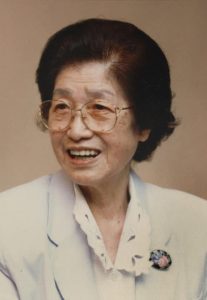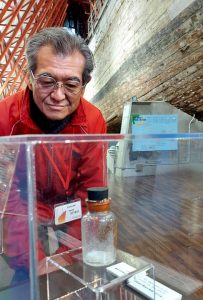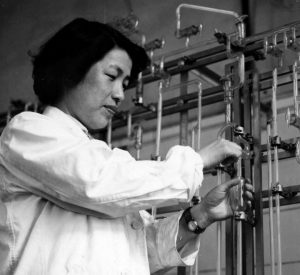An anti-nuclear life, Part 2: Katsuko Saruhashi (geochemist, 1920–2007)
Feb. 21, 2024
Scientific accomplishments should be used to benefit humanity
Analyzed “ashes of death” from Daigo Fukuryu Maru incident
by Masakazu Domen, Senior Staff Writer
The Saruhashi Award, marking its 44th anniversary this year, is granted to women scientists under the age of 50 who have made remarkable contributions to their respective fields. The award was named after its founder, Katsuko Saruhashi, and has offered encouragement to women aspiring to work in the natural sciences. A scientist herself, Dr. Saruhashi worked at the Japan Meteorological Agency’s Meteorological Research Institute, playing an active role in the field of geochemistry, an area involving research into the structural materials composing the earth, including its atmosphere and hydrosphere.
Upon her retirement from the Meteorological Agency in 1980, Dr. Saruhashi established the Saruhashi Award with funds donated by her colleagues. According to an autobiographical essay published in 1983, she established the award in hopes of “casting a ray of light amid the darkness in which women scientists are forced to work.”
Mihoko Takahashi, 81, a biologist who serves as professor emeritus at the University of Tsukuba University and the recipient of the 10th Saruhashi Award, recalled Dr. Saruhashi. “In a word, Dr. Saruhashi was strict. She said we must produce without being comfortable with our present status.” Ms. Takahashi noted, “She was especially demanding of the Saruhashi Award recipients.” After receiving the award, Ms. Takahashi started work as a clerk for the Association for the Bright Future of Women Scientists, a sponsoring organization of the award, providing administrative support to Dr. Saruhashi.
Dr. Saruhashi used to preach to younger scientists about the importance of scientists also being philosophers, citing the words of Yasuo Miyake (1908–1990), a former mentor of hers at the Meteorological Research Institute. Her experience as a scientist of being confronted by global pollution from nuclear testing served as the backdrop to her belief system.
In 1954, working at the Central Meteorological Observatory (the predecessor to the present-day Meteorological Agency) in Tokyo, Dr. Saruhashi was known as a “master of microanalysis” based on her results in analysis of carbonic substances in sea water, following her research into the earth’s ozone layer. Brought to the observatory that year were the “ashes of death,” which had captured Japan’s attention.
Earlier, on March 1 of the same year, a Japanese tuna fishing boat had been affected by a hydrogen bomb test conducted by the United States on the Bikini Atoll in the Pacific Ocean. The crew members, exposed to white ashes that fell from the sky, later exhibited acute symptoms of radiation exposure. The encounter became known as the Daigo Fukuryu Maru (Lucky Dragon No. 5) incident, which would create a groundswell of opposition to atomic and hydrogen bombs as the third instance of nuclear devastation inflicted on Japan, following the atomic bombings of Hiroshima and Nagasaki.
While research on identification of radionuclides contained in the ashes was being conducted at the University of Tokyo and elsewhere, Dr. Saruhashi was charged with analysis of the ash components. She reported the results of her analysis on May 28, the same day the ashes had been brought to the agency. Those results made up part of the data proving that the hydrogen bomb had distributed calcium carbonate from sea coral into the sky as it was being broken down by the bomb test’s intense heat.
From that time, Dr. Saruhashi would take head on the issue of nuclear pollution on earth from the perspective of a scientist. Amid the series of nuclear tests taking place around the world, she assumed the responsibility of analyzing radioactive substances in rainfall and sea water.
People still talk about how Dr. Saruhashi responded when a U.S. research institute expressed doubts about the analysis methods she used in her measurements of cesium levels in Japanese coastal waters in 1961, saying that the figures were excessive in comparison with their own data. She traveled to the Unites States by herself and won an analysis competition against U.S. researchers using the same test sample. Not only proving the high accuracy of and winning recognition and trust for Japan’s analytics, she also demonstrated the severity of pollution generated by nuclear testing.
Dr. Saruhashi served as a director of the Daigo Fukuryu Maru Peace Association, based in Tokyo, from 1982 until the last years of her life. The association, an incorporated foundation that manages the Daigo Fukuryu Maru Exhibition Hall, opened in 1976 with the aim of banning nuclear weapons and fostering ideas of peace.
Dr. Saruhashi engaged in action that embodied her beliefs and philosophies expressed in her autobiographical essay. “A-bomb victims in Hiroshima and Nagasaki and those exposed to radiation in the Bikini Atoll are fathers, mothers, and brothers.” She also described in the essay how, “Truths discovered by scientists are common assets of humankind and should be used and developed only for human happiness and well-being. They must not be used to kill people in other countries.”
Meanwhile, Kazuya Yasuda, 71, a long-time acquaintance of Dr. Saruhashi who worked as a curator at the museum, recalled her words and actions. “Instead of waving the flag of opposition to war and nuclear weapons, she stuck to her stance that she would spare no advice as a scientific expert.” Mr. Yasuda added, “She appeared all the more indomitable by directly taking on the ashes of death.”
Dr. Saruhashi was the first woman member of the Science Council of Japan among its 210 members. She served on the Science Council during its 12th term, 1981–1985.
The Science Council of Japan, established in 1949 as an organization representing all of Japan’s scientists, has consistently stated its stance to never engage in scientific research for military purposes. On the other hand, the organization has continued to debate its own role, indicating its concern about how in recent years, the distance between science and military is narrowing. What would Dr. Saruhashi say if she were still alive?
Katsuko Saruhashi
Born in Tokyo, Ms. Saruhashi graduated from the Imperial Women’s College of Science (present-day Faculty of Science, Toho University) in 1943 and began work at the Central Meteorological Observatory as a temporary employee. Obtaining her doctorate in science from the University of Tokyo in 1957, she has held such posts as general manager of the Geochemical Research Department at the Japan Meteorological Agency’s Meteorological Research Institute. The photograph was taken in 2003. (Photo provided by the Association for the Bright Future of Women Scientists)
(Originally published on February 21, 2024)










